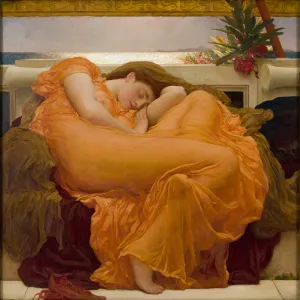The Artist and His Masterpiece
Frederic Leighton (1830–1896) was one of the most eminent artists of the Victorian era. A painter and sculptor, as well as a long-time president of the Royal Academy, he is the only British artist to have been ennobled, becoming in the last year of his life Lord Leighton, Baron of Stretton. Leighton spent much of his youth abroad, pursuing artistic training in various European cities before establishing himself in London in 1859, an experience that set him apart from many of his British contemporaries. While often treating complex themes from literary sources, Leighton embraced the avant-garde movement of Aestheticism, which emphasized formal beauty over content. Flaming June is Leighton’s masterpiece and his most direct expression of the aesthetically beautiful. The painting was lent by the Museo de Arte de Ponce, Puerto Rico, and its presentation at The Frick Collection marked its first appearance in New York in more than thirty-five years. Displayed with it is the oil sketch — generously lent by a private collector — that Leighton made to determine the painting’s color scheme. The sketch and finished painting had not been seen together since the end of the nineteenth century. The two works were surrounded by the Frick’s four portraits by Leighton’s contemporary James McNeill Whistler.
Painted in the last year of Leighton’s life, Flaming June belongs to a series of late works that feature single female figures in various attitudes. Pushed up close to the picture plane, the sleeping woman, rounded in on herself, forms a circular shape within a perfectly square canvas. The intense orange of her robe conveys the scorching heat of the imaginary Mediterranean setting while its semi-transparent fabric reveals glimpses of her naked body beneath — both contributing to the sensuality of the image. Her pose was inspired in part by Michelangelo’s famous sculpture Night, made for the Medici tomb in Florence, and his infamous erotic painting Leda and the Swan. The oleanders — lush, fragrant, and highly poisonous flowers — may allude to death or danger. Is this voluptuous figure more femme fatale than sleeping beauty? Or is she the personification of the month of June? Leighton left no written clues as to the meaning of the painting or its title. The elusive subject, along with the combination of brilliant color and complex pose within a strikingly simple composition — the distillation of a lifetime’s preoccupation with formal beauty — have cast their spell on generations of viewers.
When first exhibited at the Royal Academy in 1895, Flaming June was received to critical acclaim. The painting subsequently passed through several private collections and was forgotten during the middle of the twentieth century, when Victorian art was out of favor. Rediscovered only in 1962, it was purchased a year later by Luis A. Ferré, the forward-looking founder of the Museo de Arte de Ponce, which had been established in 1959. Ferré collected across a wide range of schools of western art while building particular strength in nineteenth-century British painting. Flaming June is the capstone of the museum’s internationally renowned holdings of Victorian art and the signature work of the collection as a whole.
Frederic Leighton (1830–1896), Flaming June, ca. 1895. Oil on canvas. Museo de Arte de Ponce. The Luis A. Ferré Foundation, Inc.

